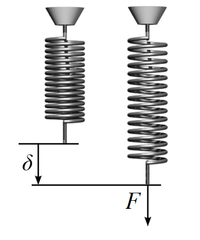
Photo from wikipedia
Consideration is given to dynamic behavior of cylindrical pressure pipe with elastic boundary conditions. Based on Sanders’ shell theory and Hamilton principle, the system equations are established for integrating the… Click to show full abstract
Consideration is given to dynamic behavior of cylindrical pressure pipe with elastic boundary conditions. Based on Sanders’ shell theory and Hamilton principle, the system equations are established for integrating the uniform distributed pressure into the elastic boundary condition. In the analytical formulation, the Rayleigh–Ritz method with a set of displacement shape functions is used to deduce mass, damping, and stiffness matrices of the pipe system. The displacements in three directions are represented by the characteristic orthogonal polynomial series and trigonometric functions which are satisfied with the elastic boundary conditions, which are represented as four sets of independent springs placed at the ends including three sets of linear springs and one set of rotational spring. The pressure pipe always suffers a uniform distributed pressure in radial direction. To verify the accuracy and reliability of the present method, several numerical examples with classical boundary condition, including free and simply supported supports are listed and comparisons are made with open literature. Then the influences of boundary restraint stiffness and the distributed pressure on natural frequency and the forced vibration response are studied: The natural frequencies increase significantly as the restraint stiffness or the distributed pressure increases. Compared to the rotational spring stiffness, the stiffnesses of axial, radial, and circumferential springs have more significant effect on natural frequency. And the lower modes are more sensitive on restraint stiffness than higher modes. But the variation of natural frequency with respect to the spring stiffness decreases monotonically with the increasing distributed pressure. The forced vibration response is also affected by the restraint stiffness.
Journal Title: Proceedings of the Institution of Mechanical Engineers, Part C: Journal of Mechanical Engineering Science
Year Published: 2017
Link to full text (if available)
Share on Social Media: Sign Up to like & get
recommendations!